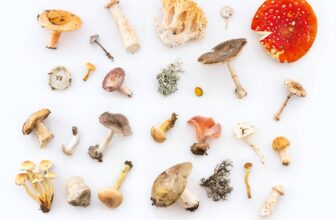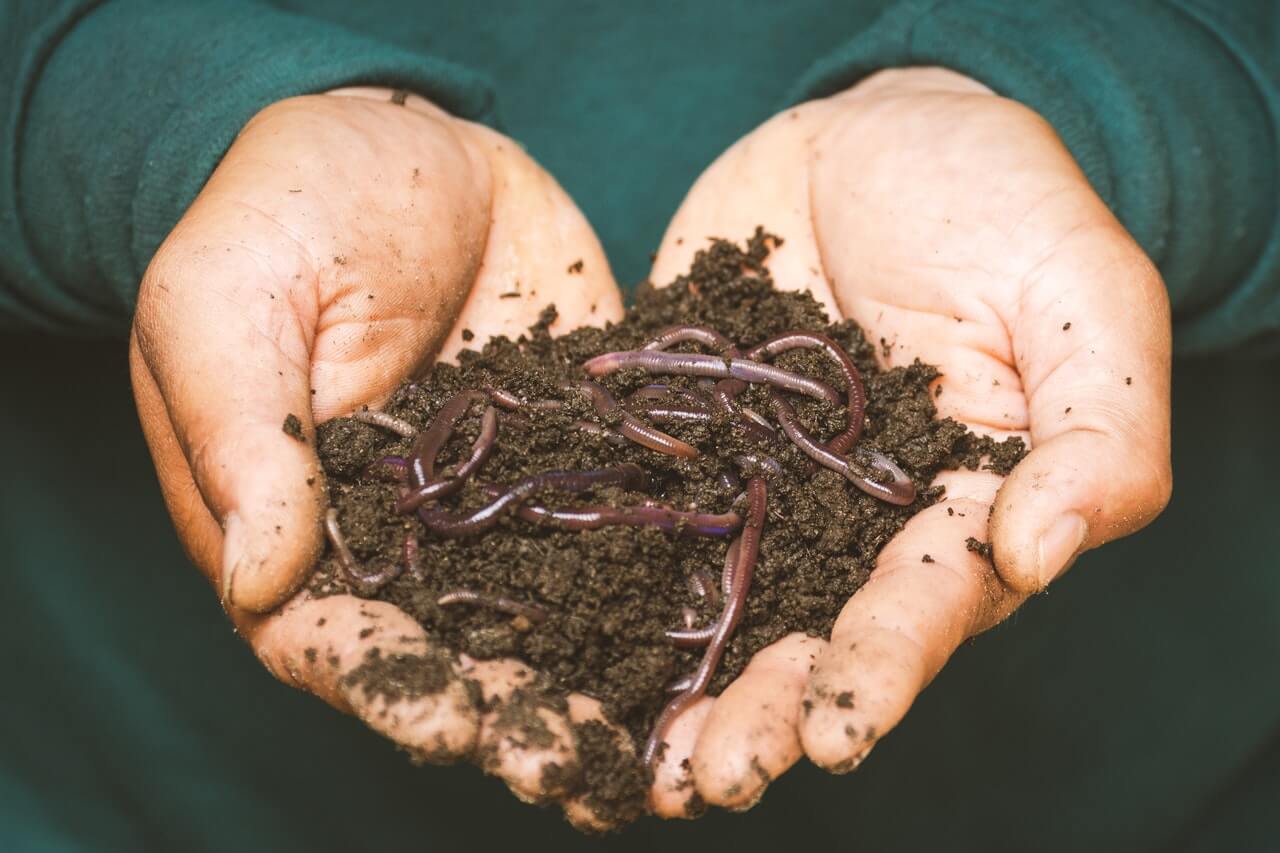
Table of Content
Looking for a more efficient way to decompose your organic waste? Then vermiculture is the best solution for you. Not only it will help you with managing your day-to-day waste productively, but will also provide you with an abundant supply of rich organic fertilizer for your garden.
In this article, we’ve got all the information you need to know about vermiculture, its pros and cons, and how to build your very own worm farm at home. Let’s get started!
What is “Vermiculture”?
Vermiculture is the process of cultivating and harvesting worms in a man-made, controlled environment. Also called ‘worm farm’, this method involves breeding earthworms for commercial or other agricultural purposes.
The result is the production of “vermicompost”, which is formed by the decaying process of natural waste by the said worms. Worm compost is acknowledged by the experts in the field as “black gold” since it’s considered the best natural fertilizer a gardener could ever ask for.
Pros and Cons of Vermiculture
Building and managing a worm farm has its pros and cons. Let’s take a look at what they are, starting with the pros:
Pros of Building Your Own Worm Farm
- Cost-effective in the long run.
- An efficient waste management system.
- Nature-friendly process.
- Free supply of rich, organic fertilizer.
- Odorless composting.
- Better soil and healthier plants.
Cons of Building Your Own Worm Farm
- Higher initial cost.
- High maintenance.
- The process can be time-consuming and cumbersome.
- Displeasing smell.
- Pests and harmful micro-organism problems.
- Slow results.
How to Build a Worm Farm
Nowadays, there are various ready-made worm farming products that you can buy on the market. However, for most of them you might have to pay a hefty price, so building your own would be more convenient and cost-effective.
Here’s what you need to know to build your own worm farm at home by yourself.
What You’ll Need:
1. Worms
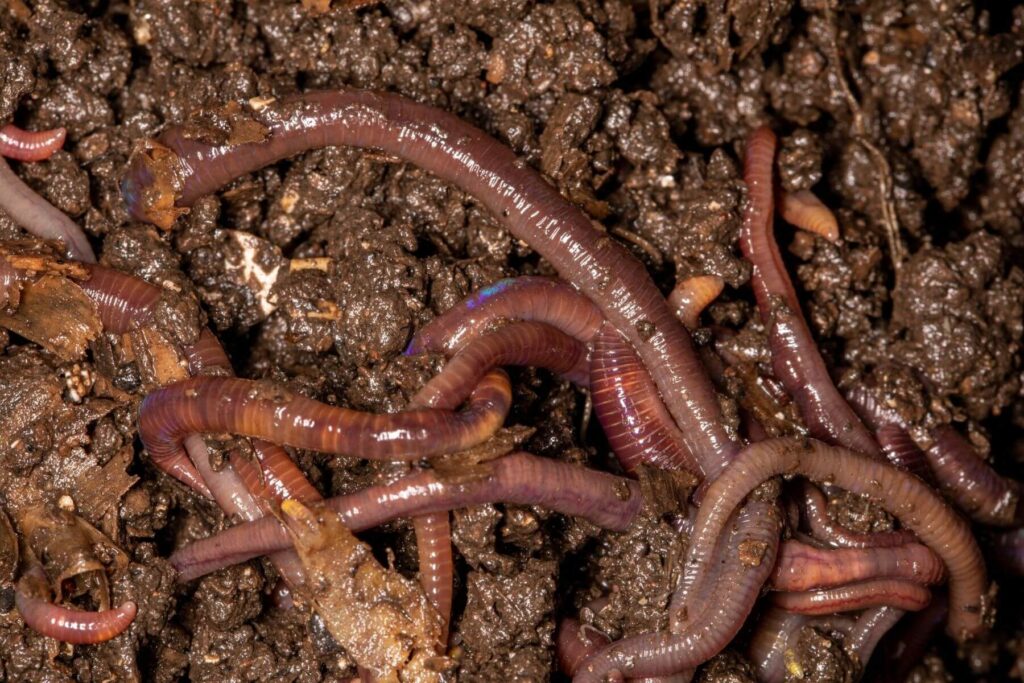
Red worms (Lumbricus rubellus) and Red wigglers (Eisenia fetida) are the two most popular types of worms for worm farming. You can find these worms in garden centers and bait shops for a fair price. They’re easy to manage and breed very quickly. With a bit of your help, they can work magic on your organic waste and soil.
2. Containers or Bins
While you can use any type of container, plastic or rubber bins/containers are ideal (one with a lid and the other/others without the lid). They’re the most commonly used, easy to stack, and simple containers you can use. You can choose to have two or more.
3. Newspapers
You’ll need enough newspaper to fill the containers at least 3-4 inches and more to add regularly. Apart from newspapers, you can use any other kind of paper that’s light and easy to rip. Avoid using hard, bright-colored, shiny papers as they won’t decompose easily.
4. A Drill and Drill Bit
Choosing the right-sized drill bit can be a tricky job sometimes. It can be different based on the container materials and the design of each worm farm. The holes you drill into the container should be between 2mm – 5mm in diameter, not too big and not too small.
5. Waste to Compost
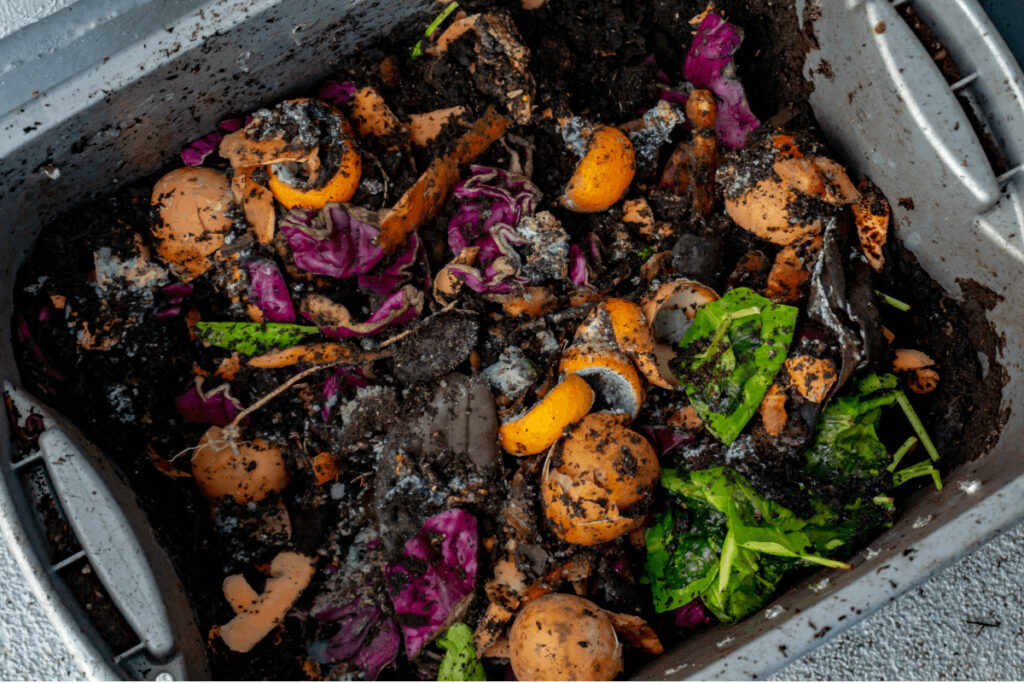
You will need kitchen left-overs such as vegetable and fruit scraps, bread crumbs, coffee grounds, tea leaves, and cereal are ideal for composting.
Avoid using any dairy and oil products such as cheese, yoghurt, and meat. You may also want to avoid using woody, hard, and dry waste like onion peels and wood scraps. These don’t decompose easily.
6. Screening Material
A compost screen helps to remove any large bits and pieces of waste material that haven’t decomposed completely. For this, you can use various materials such as shade cloth, water-soaked newspaper, a cardboard screen, a jute blanket, or even a compost-made screen. Remember not to use any material that will rust over time due to dampness and moisture. Decide the size according to the design of your worm farm.
7. Soil
Adding soil isn’t compulsory for worm farming since the worms produce their own soil (compost) in the vermicomposting process. However, mixing a bit of soil or dirt into the food can help with faster and better digestion. Be careful not to use any kind of soil that contains chemicals.
Now that you’ve got everything ready, you’re set to start building your worm farm. Here’s how it’s done:
8. A Thermometer (Optional)
A thermometer will be useful to measure the temperature of the soil. If you don’t have one, choose the coolest spot in your garden.
Step 1: Choose a location for your worm farm
Before you start the building process, choose the location where you want to place your worm farm. Both Red worms and Red Wigglers love dark, cold soil but they also need good ventilation. Pick a spot that’s shady and cool with a temperature of 55-70 Fahrenheit (12-.21 Celsius) and make sure the surrounding area is well aerated as well.
To measure the exact temperature, use a probe thermometer if you have one. For best results, you might have to move the farm following any seasonal climate changes.
Step 2: Prepare the containers/bins
The first step is to decide which bin goes at the bottom and which will be kept on the top. The top bin (which will be the feeder box) should have a lid on and have holes drilled in the bottom while the other bin (the compost collector) will be placed on the bottom.
This bin shouldn’t have any holes in it and the lid should be removed. If you’re planning to use more than one bin as feeder boxes, make sure they’re all drilled and prepared properly.
Step 3: Drill the holes in top container (feeder box)
The holes will help with the aeration and drainage of your worm farm which is extremely important in the maintenance process. If you’re not certain where and how the holes should be drilled, we recommend taking a pencil or a marker to mark the spots where you’re going to drill first.
For drainage, drill enough holes at the bottom of the bin and do the same with the lid for air circulation. If you feel that the aeration isn’t enough, you can also drill some holes on the sides of the bin.
Step 4: Stack the bins

Once you’ve drilled the holes, place the drilled bin on the top and the undrilled one on the bottom. If the bins are different in size and design can’t be stacked easily, you can always use a brick or a pot for support. Place the brick or pot inside of the first container and then place the other bin on top of it.
Step 5: Make the bedding
Soak the newspaper in water until it’s moist but not too soggy. Squeeze out the excess water and fill the top container with the wet newspaper. The layer should be at least three to four inches thick. Mix the soil with the newspaper and you can also add some dried leaves if you like. It will improve the bedding further.
Step 6: Add the organic waste
Lay out the waste material on the bedding in the drilled container as worm food. Check out this list of different types of waste material you should and shouldn’t add to your compost.
Step 7: Put the worms in
Now, your worm farm is ready for the worms. Place them inside the drilled bin on the top of the bedding and organic waste. Since worms like dark and cool environments, they will crawl in and hide between the scraps and the bedding.
Step 8: Cover the worms with the screening material
Use the screening material you chose to cover the worms. Lay it on the top of the bedding of the drilled container. If you have drilled any holes not just on the lid but also at the four sides of the bin, you can use some wet cardboard or sheet of newspapers to seal them so that the worms won’t be able to wriggle out.
Finally, secure the worm farm by placing the lid of the top container back on, and keeping it closed.
Maintaining Your Worm Farm
It’s important to maintain your worm farm to keep it in a good state. Add scraps to the bin on a weekly basis to maintain it, as you don’t have to feed the worms daily.
The worms may eat some things more quickly than others, so remember to monitor what they eat and replace it more often. Provide them with a variety of food as it will stimulate their consumption and digestion. Take note of the things that the worms haven’t eaten, if there aren’t any, and don’t put them into your scrap collection the next time.
From the second feeding, always remember to cover the added waste with some shredded, wet newspaper to keep the stench and flies out. When the feeding is done, replace the lid.
Collecting Vermicompost and Compost Tea
Worm farms generate results much slower than regular composting as worms take time to adapt to their new environment. Once they’ve adapted, you can harvest the compost and liquid once every few months. The vermicompost that’s ready to be harvested should be a rich dark brown to a black color and will look and feel like coffee grounds.
To scoop the worm compost, you’ll first need to move the worms to one side of the container by placing their food on that side. Within a few days, all the worms will be on the side where the food scraps are, leaving the other side empty. After making sure that there are no worms left on the side you’re trying to dig, carefully take out the compost by using any fitting tool like a cup, bucket, shovel, or ladle.
Though it’s not compulsory, having a tap or another outlet installed into the bottom bin beforehand makes it much easier to take out the compost tea. If you don’t have it, you can detach the top container (the feeder box) from the bottom one and scoop out the compost tea with a cup or a bucket before putting the bins together again.
The Take-Away
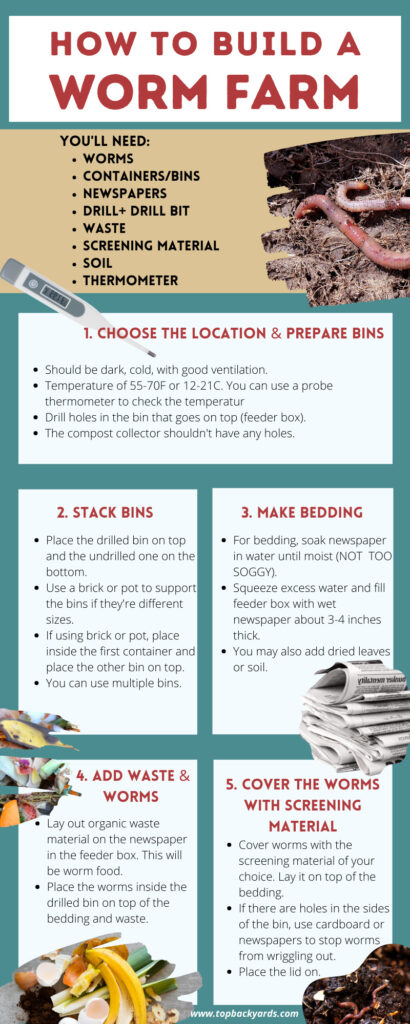
Worm farming is an excellent way to recycle your organic waste and produce natural fertilizers for your plants. Not only is it very satisfying, but it can also be a rewarding experience. If you start building your own farm right away, you’ll be able to reap the rewards in a few months.




